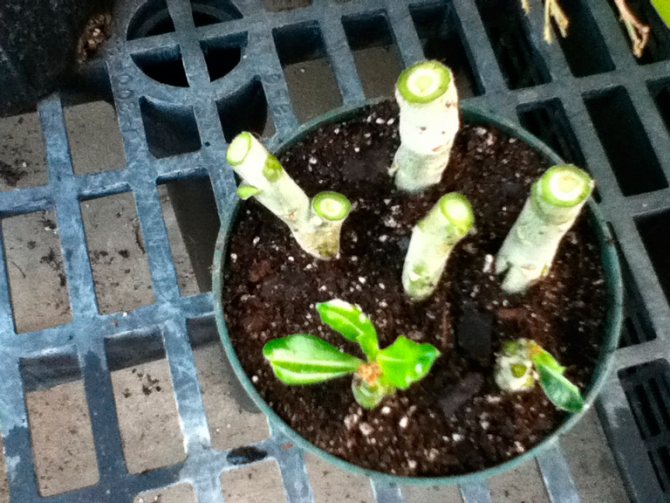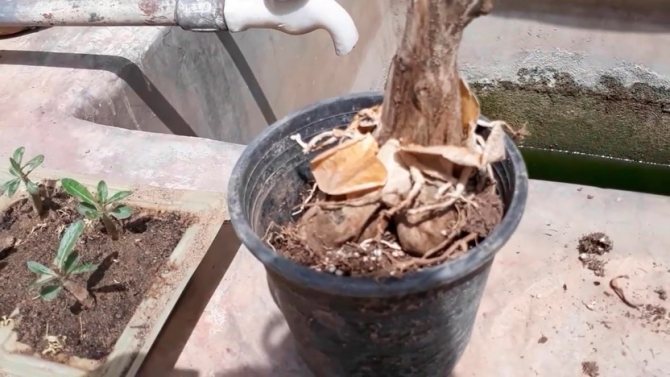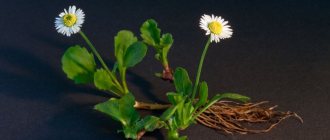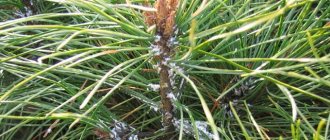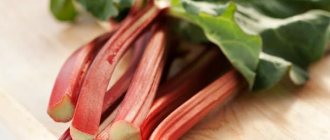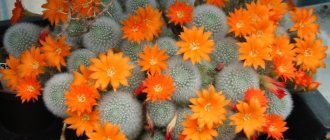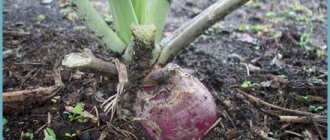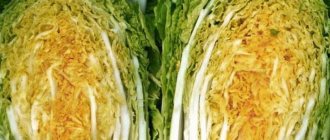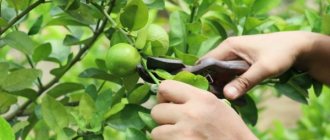»Flowers» Adenium transplant - timing and technique
0
71
Article rating
Adenium transplant is a mandatory event, without which the full development of a home flower is impossible. Consider the basic rules of the procedure and how to choose the right substrate and pot.

Adenium transplant - timing and technique
Description
Adeniums belong to the Kutrov family. At first, they grew only on the lands of Saudi Arabia. It was from there that travelers brought the "desert rose" to Europe.
This miniature tree has a fleshy, thickened trunk from top to bottom, mostly underground. Branched shoots grow up from the trunk. For this reason, the plant is often referred to as a shrub plant. Under natural conditions, however, it sometimes reaches a height of 8 m. Moisture accumulates in the thickened part to provide the plant with it in dry times. For this feature, the plant is also called bottle.
The roots of the plant are thick, fleshy, grow in breadth after planting in a pot. The roots look unusual and amaze with their decorative effect.
Leaves are small, elongated, rounded at the ends. Their surface is glossy or velvety. They are located on short cuttings alternately or in bunches.
The plant is flowering. Its inflorescences amaze with their beauty and grace, located on the tops of the branches in the form of bunches. The flowers resemble simple funnels, are large and have many interesting shades. Sometimes there are species with double flowers. The flower "funnel" itself is colored non-uniformly, towards the center it brightens. There are very different shades: from bright to pale.
In the adenium plant, flowering usually begins in spring, summer or early autumn. Flowering lasts a long time, usually several months. Blooms in April - July or September - October, if it feels comfortable. But when artificial lighting is created, this plant can be “made to bloom” in other months.
Adenium transplant, soil and pot selection
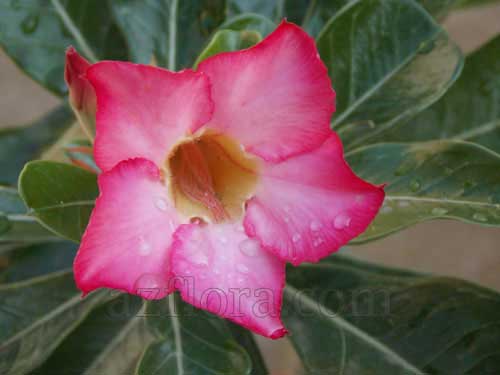

The soil mixture for growing Adenium should have a high drainage property, low moisture content and the presence of nutrients.
To ensure drainage properties add (optional) to the mixture: sand, perlite, slag, brick chips, gravel, bark, walnut shells, charcoal. These materials make up (30-70)% of the volume of the potting mix, depending on its recipe. In addition to providing high drainage properties, they have an insignificant moisture capacity.
The moisture content of the soil mixture increases by adding to its composition (at choice): sod land, compost, leaf humus, clay (loam). These materials make up up to 40% of the potting mix, depending on the recipe and as an additional plus, they contain nutrients.
The nutritional value of the mixture is increased by adding organic and mineral fertilizers to its composition. Organic fertilizers can be up to 20% of the volume of the soil mixture. Most often, humus of cattle is used as a component of the soil mixture.
The optimum acidity of the soil mixture is pH (6.5-7.8). The acidity of the mixture - an important indicator - ensures the availability of nutrients to the plant.
For plants whose caudex is more than 1.5 cm (1/2 ″) in diameter, cultivated in a temperate continental climate, I recommend the following composition of the soil mixture: 1 part turf + 1 part leaf humus + 1 part cow humus + 3 parts sand ( fraction 2-3mm). After compiling, the potting mix is sterilized.
For planting, you can use ready-made mixtures. If there are no mixtures for adenium on sale, then you can purchase a ready-made soil mixture for planting cacti or other succulent plants. Add 30% sand (by volume of the mixture) to the mixture for cacti and use it for planting adenium.
When compiling the soil, I do not recommend replacing the sand with perlite, due to the fact that it is washed out from the upper layers and accumulates on the surface of the substrate, spoiling the appearance of the composition.
Pot selection
A mandatory requirement when choosing a pot is the presence of a drainage hole.
Adenium, in the early years, develops a powerful vertical root, so young plants are planted in classic, deep pots. A mature plant (caudex diameter from 6 cm) is planted in a shallow pot or bowl, since its root system mainly develops to the sides.
The size of the pot is chosen to be equal to two diameters of the caudex.
The material of the pot does not really matter: both plastic and ceramic pots are used. With the further cultivation of adenium, take into account the fact that the soil dries out faster in a ceramic unglazed pot than in a plastic or ceramic coated pot. As the plant grows, the roots of the plant burst the walls of the pot and quite often destroy it. Therefore, when growing a mature plant, the most practical is a bowl-shaped pot - a bowl.
Adenium transplant
The optimal time for transplanting is the end of winter, the beginning of spring (for the temperate zone), that is, before the start of active growth. Plants should not be delayed with transplanting, because by autumn the roots of adenium must fill the entire volume of soil in the pot, otherwise the likelihood of putrefactive diseases increases.
Young plants are transplanted 1-2 times a year, adults - once every two years.
When replanting a young plant, the old soil is removed completely. If a mature plant is transplanted, it is also advisable to remove all the old soil (it is convenient to wash it with a stream of water).
In the culture of breeding adenium, in some cases, the transplant is carried out without removing the old soil, that is, the plant, together with the earthen lump, is placed in a larger container, and the free space is filled with fresh soil.
I recommend removing the old soil completely, since over time it changes its structure due to the decomposition of its constituent components. Also, salts accumulate in the soil, which enter it when irrigated with hard water, or accumulate when feeding. The accumulated salts change the acidity of the soil mixture, and this already creates a problem in the nutrition of the plant.
After removing the old soil, we inspect the root system for defects. Further, if necessary, we carry out root pruning. Sprinkle the cuts with charcoal powder.
In the planting pot, we cover the drainage hole with a crock, but so as not to block the water that should flow through it.
If the plant has damaged large roots, then after transplanting the adenium for 7 days we do not water it - this is the time necessary for the healing of the damage received by the plant during transplantation. If there was no damage to large roots, then you can water immediately after transplanting.
To form bizarre shapes, when transplanting, adenium is raised above the soil level by 1-3 cm.
After the first watering, the surface of the substrate can be mulched with gravel or brick chips.
Why does not it bloom


Sometimes this perennial can stop blooming and not bloom for several years. Before worrying, it is necessary to establish the exact age of the desert rose. And if she is old enough, then you need to establish the reasons. The reasons for this phenomenon are:
- bust with nitrogen fertilizers;
- lack of lighting;
- excessive watering in the cold season, causing root rot;
- improper care during the rest period.
Pot requirements
When choosing a pot container for adenium transplant, a number of features of the growth of a flower culture are taken into account.
Material. It can be anything - ceramics, clay or plastic. However, it affects the watering regime.
- In clay and ceramic containers without a glazed outer coating, water evaporates faster, because this happens not only from the surface layer of the substrate, but also through the porous walls of the pot itself. It is also difficult to analyze the time to change the pot.
- Moisture leaves the plastic container much more slowly, therefore, when watering, you should not allow waterlogging and stagnation, which provokes rotting of the roots. The material under the pressure of the overgrown inner space of the root system begins to stretch, indicating the need for transplantation.
The form. Depends on the condition of the roots. When growing a home flower with root shoots branching to the sides, preference is given to shallow pots and a large diameter to allow the underground part to develop in width.
For some varieties, for example, the Somali, which is characterized by vertical growth, deep, but not wide, is necessary.
The size. When choosing a container for transplanting, choose a diameter that exceeds the area of the roots by 3-5 cm. However, it is not worth replanting a plant in a pot that is too wide, because initially, the flower culture will begin to actively develop the interior space, building up the underground part without flowering, and only then will it begin to start up fresh shoots and inflorescences.
Care rules
Before making adenium bloom at home, comfortable conditions are created for him. A lot of time and effort is not required to take care of a desert guest. There are no such plants that require a lot of attention in deserts. Therefore, we make this plant bloom without making huge efforts to this.
Lighting
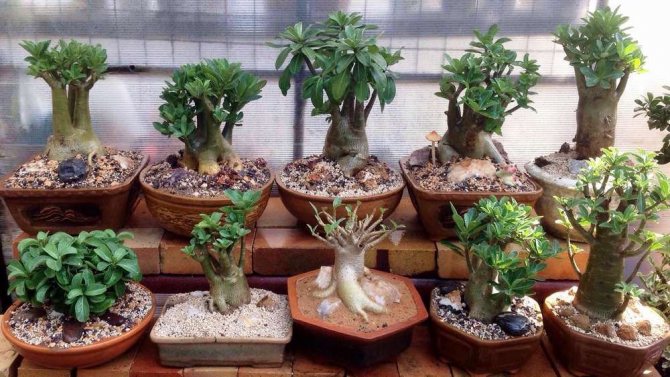

Since the perennial is light-loving, therefore it should be placed in the brightest place. The most suitable for this is a window sill, with a window facing south or southwest. Unless young seedlings from seeds cannot be placed on such a window.
During the rest period
The dormant period begins at the end of autumn. Adeniums must be "sent to rest". Otherwise, they will not bloom, and if they bloom, then there will be few flowers, and the flowers themselves will appear small and pale.
For this, the container with the flower is placed in a slightly shaded place. You also need to reduce watering to one per month. The temperature in the room should be no more than 15 ° C. Do not be alarmed if the plant sheds its leaves.
Regular pruning and pinching
At the beginning of the first spring month, when the perennial begins to "come to life" after hibernation, cut off its shoots. This allows the crown to form and encourages the bud setting.
You can also trim the roots. Particularly interesting shapes are obtained when the plant is planted on a round plate. In this case, the root grows to the sides like an octopus. Roots can be strengthened with sticks or toothpicks, giving the roots an exotic look. In any case, the pruning and crown shaping operation must be performed before the plant begins to bloom.
It should be remembered that adeniums should not be cut low. Pruning too low results in irregular, thin stems and prevents the formation of the correct crown shape.
Pinching refers to cutting off the tops of the central conductors and lateral shoots. Cut twigs 1-2 cm. This is the same pruning process, only small tops are cut off.Nipples and pruning help stimulate branching and crown formation.
How to properly transplant a plant outdoors?
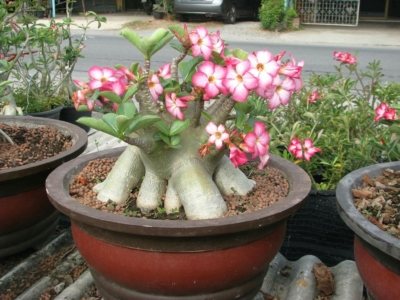

Some varieties of adenium can be planted outdoors... Instructions:
- Remove the plant from the previous container. Carefully remove the soil from the roots. Rinse under warm water.
- Cut the roots a little. Sluggish stems, as well as dry ones - cut off.
- Dry the slices. And on the roots, additionally treat with charcoal or fungicide.
- Plant a plant in a prepared hole in the open field. Do this so that the hole is in depth exactly for the root system of this flower.
- Cover the roots with earth. Then sprinkle the base of the flower with soil a little, and then pour it with warm water.
Flowering adenium
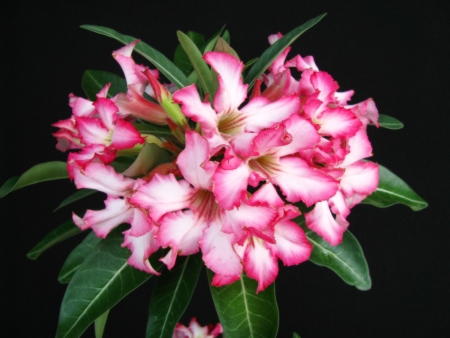

Each grower should be prepared for the fact that the first flowering of adenium will be defective: the buds will appear, but the plant will not have enough strength to fully bloom. However, this is not a reason to despair, because the buds that appear indicate that in the future adenium will definitely bloom. As a rule, flowering occurs two years after sowing the seeds, however, flowers can appear after three, even four years. The flowering rate depends on several factors.
- Plant growing conditions. If you provide it with light, warmth, nutrients and a good substrate, then flowering will probably come quite early.
- Plant type. Earlier and easiest of all, adenium Obesum blooms, but adenium Arabicum belongs to the long-thinking species.
- Calm, only calm. As soon as you see the buds on the plant, do not touch the flower, do not transfer it from place to place, do not twist the flowerpot.
Adenium buds bloom very slowly - over the course of a month. This is why it is important to be patient.
How to make adenium bloom at home? Why are there no buds and what kind of care does the plant need?


A rare flower has no history of its own, full of legends and superstitions. The desert rose, often used in landscape design, is no exception. How to take care of him at home? Adenium is distinguished by spectacular flowering. At home, the plant often refuses to form buds or quickly sheds them. To prevent this, it is important to know how to properly care for your adenium.
The birthplace of the flower and its appearance
Adenium is a shrub or woody succulent plant from the Kutrov family. It is believed to be native to Saudi Arabia and grows mainly in the desert.
The trunk of the plant is fleshy, thickened towards the base (caudex) and strongly branched. The leaves are green, smooth, shiny and elongated. The bulk of the crown is made up of flowers of incredible beauty. Huge with a variety of colors: pink, red - black, white and yellow. The turgor can also be different: simple and terry.
Lighting and temperature control
For the full development of the adenium, the brightest lighting is necessary. African motto: the more sun, the better. If in the store the pot with the plant was pushed into a dark corner, immediately after the purchase it is impossible to expose it to the sun in any case - the pet should get used to the direct rays gradually. It is also undesirable to turn the pot during the growth period, otherwise burn spots will appear on the sections of the trunk that were previously in the shade.
As for the ambient temperature, in the summer months adenium feels great at + 25 ... + 30 ° C and prefers to spend "holidays" in the fresh air. When moving an African to a balcony or garden, care should be taken to ensure that the place of his detention is reliably protected from precipitation.
How to make adenium bloom at home
In natural conditions, adeniums are large trees, they grow up to ten meters in height. In conditions of home keeping, the flower is a small plant, quite popular.The genus Adenium consists of 10 or 11 different taxa (species and subspecies).
Adeniums, which are sometimes called desert roses, are amazingly beautiful during their flowering, large funnel-shaped flowers reach six centimeters in diameter, they come in a variety of shades: cream, white, pink, crimson. Adenium blooms in early spring, in the month of April and until mid-summer. If conditions are created for the plant as close as possible to its native desert environment, then it will bloom a second time in September for about a month more.
The reasons
Adenium transplant can be performed for various reasons:
- After the purchase.
As soon as a copy was purchased and brought home, it is necessary to immediately transplant it. The reason for this hasty action is that in flower shops the soil is basically standard for all flowers. Adenium needs a special soil composition (what kind of soil to choose for adenium so that the flower is pleasing to the eye?). - Diseases of roots and caudex.
If the caudex and the root system decay, then there may be several reasons here: mechanical damage and the presence of a wound, moisture penetration into it, profuse waterlogging and hypothermia. To save a flower, it must be removed from the container, shaken off excess soil and using a sharp disinfected knife to cut off the lesion. Then sprinkle the cut with an antiseptic or fungicide. Once the roots are dry, they can be transplanted into a new substrate and wait for the plant to come to life. 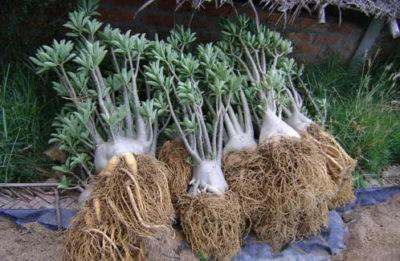

Incorrectly selected soil.
This situation arises if the adenium was donated by someone and the composition of the soil is unknown. The transplant should be carried out before the onset of the growing season.- Roomy pot.
Due to inexperience, gardeners use too spacious a container for planting adenium. In this case, it is necessary to replace the container with a suitable one as soon as possible. If the pot is too roomy or deep, water stagnation will occur, which leads to the death of the root system and the flower itself. - Small pot.
It is easy to notice that the adenium is cramped in the container, since the flowerpot will simply burst from the pressure of its roots. Neither the pot nor the soil can support the root system of the crop.
Why do adeniums stop blooming
Sometimes these indoor plants do not bloom for several years. This is mainly due to improper or insufficient care, therefore, first of all, you need to understand what exactly is being done wrong.
The reason for the lack of flowering can be:
- Low light, the plant is in a dark place.
- The flower was overfed (excess nitrogen fertilizers).
- Watering is abundant during cold weather.
- The rest period is disturbed or during it the wrong care is carried out.
So, adeniums badly need not only abundant lighting, but also spacious, correct content. In natural nature, this desert plant is accustomed to receiving a fairly large amount of sunlight, therefore, when thinking about how to make the adenium plant bloom at home, first of all, it must be placed on a window on the south side.
Also, the plant may still be too young, this species begins to bloom only in the third or even in the fourth year of its life.
Pruning
To give the crown density and splendor, flower growers resort to the formation and pruning of adenium. Sometimes these measures are necessary, since in most plants, the apical development is considered dominant, so that the rest of the shoots cannot develop, except for the central one.
ATTENTION! After the apex is removed, dormant lateral buds are activated and branching is triggered.
Thanks to this pruning, the following result is achieved:


the amount of foliage increases;- the maximum number of buds is laid;
- the crown becomes even, lush and dense.
Besides, pruning rejuvenates mature plants, and some of the branches noticeably weaken with age.Carry out pruning every 2 years, and shorten the shoots by 5-8 cm.To carry out pruning of adenium, the following tools and materials are needed:
- disposable gloves;
- manual pruner;
- soap;
- alcohol;
- warm water.
Procedure:
- Wear rubber gloves before work.
- To crush the growing point, pinch some of the stems with your fingers.
- Compare visually the thickness of the stems. The thinnest elements should be trimmed.
- Use your fingers to check all parts of the plant for firmness. Remove soft, crooked and leafless stems. Also, stems growing inward are subject to removal.
- Strongly thick branches should be pruned to stimulate the development of the entire adenium.
- Cut the remaining stems so that the bush gets the desired shape. Make the cut above the knot. The flowers are formed from the buds located under the cut.
Wintering adenium
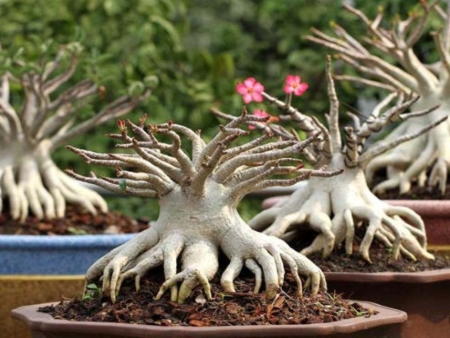

This is the most difficult period: the leaves almost completely fall off and you need to adhere to the special conditions for keeping adenium. Firstly, watering is sharply reduced, and after a while it stops. The temperature drops to +15 degrees.
With special care, you need to remove the plant from the dormant period so as not to destroy the adenium.
What if the plant does not take root?
Best of all, adenium of any varieties takes root after transplanting, if carried out in the spring. If the plant does not take root well, then it must be installed in a shaded place for 2-3 days so that the sun's rays do not bother it.
Also it is worth stopping watering for 7 days... If, under the influence of such conditions, the flower does not come to life, then you will have to get rid of it. Adenium transplant is an important procedure in the process of growing an ornamental crop.
There may be several reasons for its implementation, but in any case, the gardener must follow all the rules in the choice of soil, pot and features of care after transplantation.


